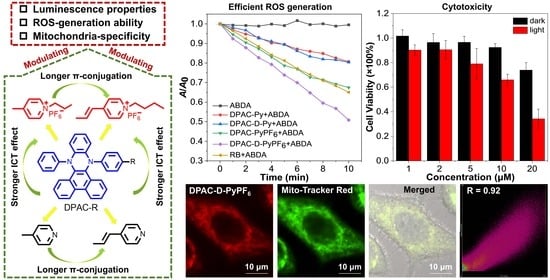Modulating the Luminescence, Photosensitizing Properties, and Mitochondria-Targeting Ability of D-π-A-Structured Dihydrodibenzo[a,c]phenazines
Abstract
:1. Introduction
2. Results and Discussion
2.1. Rational Design and Facile Synthesis of the DPAC Derivatives
2.2. Single-Crystal Structures of the DPAC Derivatives
2.3. Photophysical Properties of the DPAC Derivatives
2.3.1. Solvatochromic Effect
2.3.2. AIE/VIE Properties
2.3.3. Solid-State Emission Behaviors
2.4. Electrochemical Properties and the ICT Effect of the DPAC Derivatives
2.5. ROS-Generating and Mitochondria-Targeting Abilities of the DPAC Derivatives
2.6. Cytotoxicity of the DPAC Derivatives
3. Materials and Methods
3.1. Chemicals and Instruments
3.2. Synthesis
3.3. Density Functional Theory (DFT) Calculations
3.4. Cyclic Voltammetry Experiments
3.5. Reactive Oxygen Species (ROS) Detection in Solution
3.6. Singlet-Oxygen Quantum Yield Measurement
3.7. Cell Culture and Fluorescence Imaging
3.8. Cytotoxicity Assay
4. Conclusions
Supplementary Materials
Author Contributions
Funding
Data Availability Statement
Acknowledgments
Conflicts of Interest
Sample Availability
References
- Zhang, Z.; Kang, M.; Tan, H.; Song, N.; Li, M.; Xiao, P.; Yan, D.; Zhang, L.; Wang, D.; Tang, B.Z. The fast-growing field of photo-driven theranostics based on aggregation-induced emission. Chem. Soc. Rev. 2022, 51, 1983–2030. [Google Scholar] [CrossRef] [PubMed]
- Chen, H.; Li, S.; Wu, M.; Kenry, Huang, Z.; Lee, C.-S.; Liu, B. Membrane-anchoring photosensitizer with aggregation-induced emission characteristics for combating multidrug-resistant bacteria. Angew. Chem. Int. Ed. 2020, 59, 632–636. [Google Scholar] [CrossRef]
- Zhai, W.; Zhang, Y.; Liu, M.; Zhang, H.; Zhang, J.; Li, C. Universal scaffold for an activatable photosensitizer with completely inhibited photosensitivity. Angew. Chem. Int. Ed. 2019, 58, 16601–16609. [Google Scholar] [CrossRef] [PubMed]
- Liu, Z.; Wang, Q.; Qiu, W.; Lyu, Y.; Zhu, Z.; Zhao, X.; Zhu, W.-H. AIE-active luminogens as highly efficient free-radical ROS photogenerator for image-guided photodynamic therapy. Chem. Sci. 2022, 13, 3599–3608. [Google Scholar] [CrossRef]
- Liu, S.; Wang, B.; Yu, Y.; Liu, Y.; Zhuang, Z.; Zhao, Z.; Feng, G.; Qin, A.; Tang, B.Z. Cationization-enhanced type I and type II ROS generation for photodynamic treatment of drug-resistant bacteria. ACS Nano 2022, 16, 9130–9141. [Google Scholar] [CrossRef]
- Qin, Y.; Chen, X.; Gui, Y.; Wang, H.; Tang, B.Z.; Wang, D. Self-assembled metallacage with second near-infrared aggregation-induced emission for enhanced multimodal theranostics. J. Am. Chem. Soc. 2022, 144, 12825–12833. [Google Scholar] [CrossRef]
- Yan, S.; Sun, P.; Niu, N.; Zhang, Z.; Xu, W.; Zhao, S.; Wang, L.; Wang, D.; Tang, B.Z. Surfactant-inspired coassembly strategy to integrate aggregation-induced emission photosensitizer with organosilica nanoparticles for efficient theranostics. Adv. Funct. Mater. 2022, 32, 2200503. [Google Scholar] [CrossRef]
- Liu, X.; Li, W.; Wen, Y.; Su, L.; Zhang, X. Aggregation-induced emission (AIE)-Based nanocomposites for intracellular biological process monitoring and photodynamic therapy. Biomaterials 2022, 287, 121603. [Google Scholar]
- Tian, M.; Chen, W.; Wu, Y.; An, J.; Hong, G.; Chen, M.; Song, F.; Zheng, W.-H.; Peng, X. Liposome-based nanoencapsulation of a mitochondria-stapling photosensitizer for efficient photodynamic therapy. ACS Appl. Mater. Interfaces 2022, 14, 12050–12058. [Google Scholar] [CrossRef]
- Zhang, S.; Yang, W.; Lu, X.; Zhang, X.; Pan, Z.; Qu, D.-H.; Mei, D.; Mei, J.; Tian, H. Near-infrared AIEgens with high singlet-oxygen yields for mitochondria-specific imaging and antitumor photodynamic therapy. Chem. Sci. 2023, 14, 7076–7085. [Google Scholar] [CrossRef]
- Xu, F.-Z.; Zhu, T.; Han, H.-H.; Zou, J.-W.; Zhang, Y.; Li, J.; James, T.; He, X.-P.; Wang, C.-Y. Molecularly engineered AIEgens with enhanced quantum and singlet-oxygen yield for mitochondria-targeted imaging and photodynamic therapy. Chem. Sci. 2022, 13, 9373–9380. [Google Scholar] [CrossRef] [PubMed]
- Tian, J.; Huang, B.; Nawaz, M.; Zhang, W.; Apfel, U.; Zhang, W.; Cao, R. Recent advances of multi-dimensional porphyrin-based functional materials in photodynamic therapy. Coord. Chem. Rev. 2020, 420, 213410. [Google Scholar] [CrossRef]
- Zhang, H.; Li, Q.; Qi, X.; Li, Y.; Ma, H.; Grinholc, M.; Nakonieczna, J.; Yu, B.; Wang, X.; Zhang, L. Iron-blocking antibacterial therapy with cationic heme-mimetic gallium porphyrin photosensitizer for combating antibiotic resistance and enhancing photodynamic antibacterial activity. Chem. Eng. J. 2023, 451, 138261. [Google Scholar] [CrossRef]
- Teng, K.-X.; Chen, W.-K.; Niu, L.-Y.; Fang, W.-H.; Cui, G.; Yang, Q.-Z. BODIPY-based photodynamic agents for exclusively generating superoxide radical over singlet oxygen. Angew. Chem. Int. Ed. 2021, 60, 19912–19920. [Google Scholar] [CrossRef] [PubMed]
- Li, C.; Sun, T.; Li, X.; Xie, Z. Heavy-atom-free nanoparticles based on boron dipyrromethene derivatives for combined photothermal and photodynamic cancer therapy. ACS Appl. Nano Mater. 2022, 5, 18691–18696. [Google Scholar]
- Lv, Z.; Wei, H.; Li, Q.; Su, X.; Liu, S.; Zhang, K.; Lv, W.; Zhao, Q.; Li, X.; Huang, W. Achieving efficient photodynamic therapy under both normoxia and hypoxia using cyclometalated Ru(II) photosensitizer through type I photochemical process. Chem. Sci. 2018, 9, 502–512. [Google Scholar] [CrossRef]
- Dai, J.; Duan, C.; Huang, Y.; Lou, X.; Xia, F.; Wang, S. Aggregation-induced emission luminogens for RONS sensing. J. Mater. Chem. B 2020, 8, 3357–3370. [Google Scholar] [CrossRef]
- Lovell, J.F.; Liu, T.W.B.; Chen, J.; Zheng, G. Activatable photosensitizers for imaging and therapy. Chem. Rev. 2010, 110, 2839–2857. [Google Scholar] [CrossRef]
- Lovell, J.F.; Jin, C.S.; Jin, E.H.; Kim, C.; Rubinstein, J.L.; Chan, W.C.W.; Cao, W.; Wang, L.V.; Zhang, G. Porphysome nanovesicles generated by porphyrin bilayers for use as multimodal biophotonic contrast agents. Nat. Mater. 2011, 10, 324–332. [Google Scholar] [CrossRef]
- Wang, Y.; Zhong, Y.; Zhang, X.; Qu, D.-H.; Mei, D.; Mei, J. Facile construction of AIE-active pyridinyl-diphenylacrylonitrile derivatives with optical properties finely modulated by D–A regulation. Mater. Chem. Front. 2022, 6, 2103–2113. [Google Scholar] [CrossRef]
- He, X.; Yang, Y.; Guo, Y.; Lu, S.; Du, Y.; Li, J.-J.; Zhang, X.; Leung, N.L.C.; Zhao, Z.; Niu, G.; et al. Phage-guided targeting, discriminative imaging, and synergistic killing of bacteria by AIE bioconjugates. J. Am. Chem. Soc. 2020, 142, 3959–3969. [Google Scholar] [CrossRef]
- Niu, N.; Yu, Y.; Zhang, Z.; Kang, M.; Wang, L.; Zhao, Z.; Wang, D.; Tang, B.Z. A cell membrane-targeting AIE photosensitizer as a necroptosis inducer for boosting cancer theranostics. Chem. Sci. 2022, 13, 5929–5937. [Google Scholar] [CrossRef] [PubMed]
- Yu, Y.; Liu, Y.; Chen, Y.; Chen, J.; Feng, G.; Tang, B.Z. Cationic AIE-active photosensitizers for highly efficient photodynamic eradication of drug-resistant bacteria. Mater. Chem. Front. 2023, 7, 96–105. [Google Scholar] [CrossRef]
- Liu, P.; Ren, F.; Son, S.; Ji, M.S.; Li, P.; Cai, Z.; Shi, J.; Liu, Y.; Dong, Y.; Kim, J.S. Mitochondrial targeted AIEgen phototheranostics for bypassing immune barrier via encumbering mitochondria functions. Biomaterials 2022, 283, 121409. [Google Scholar] [CrossRef]
- Zhang, Z.; Wu, Y.-S.; Tang, K.-C.; Chen, C.-L.; Ho, J.-W.; Su, J.; Tian, H.; Chou, P.-T. Excited-state conformational/electronic responses of saddle-shaped N,N′-disubstituted-dihydrodibenzo[a,c]phenazines: Wide-tuning emission from red to deep blue and white light combination. J. Am. Chem. Soc. 2015, 137, 8509–8520. [Google Scholar] [CrossRef] [PubMed]
- Chen, W.; Chen, C.-L.; Zhang, Z.; Chen, Y.-A.; Chao, W.-C.; Su, J.; Tian, H.; Chou, P.-T. Snapshotting the excited-state planarization of chemically locked N,N′-disubstituted dihydrodibenzo[a,c]phenazines. J. Am. Chem. Soc. 2017, 139, 1636–1644. [Google Scholar] [CrossRef]
- Zhang, Z.; Chen, C.-L.; Chen, Y.-A.; Wei, Y.-C.; Su, J.; Tian, H.; Chou, P.-T. Tuning the conformation and color of conjugated polyheterocyclic skeletons by installing ortho-methyl groups. Angew. Chem. Int. Ed. 2018, 57, 9880–9884. [Google Scholar] [CrossRef]
- Zhang, Z.; Song, W.; Su, J.; Tian, H. Vibration-induced emission (VIE) of N,N′-disubstituted-dihydribenzo[a,c]phenazines: Fundamental understanding and emerging applications. Adv. Funct. Mater. 2020, 30, 1902803. [Google Scholar] [CrossRef]
- Sun, G.; Wei, Y.; Zhang, Z.; Lin, J.; Liu, Z.; Chen, W.; Su, J.; Chou, P.-T.; Tian, H. Diversified excited-state relaxation pathways of donor-linker-acceptor dyads controlled by a bent-to-planar motion of the donor. Angew. Chem. Int. Ed. 2020, 59, 18611–18618. [Google Scholar] [CrossRef] [PubMed]
- Zhang, Z.; Sun, G.; Chen, W.; Su, J.; Tian, H. The endeavor of vibration-induced emission (VIE) for dynamic emissions. Chem. Sci. 2020, 11, 7525–7537. [Google Scholar] [CrossRef]
- Jin, X.; Li, S.; Guo, L.; Hua, J.; Qu, D.-H.; Su, J.; Zhang, Z.; Tian, H. Interplay of steric effects and aromaticity reversals to expand the structural/electronic responses of dihydrophenazines. J. Am. Chem. Soc. 2022, 144, 4883–4896. [Google Scholar] [CrossRef]
- Zong, Z.; Zhang, Q.; Qiu, S.; Wang, Q.; Zhao, C.; Zhao, C.; Tian, H.; Qu, D.-H. Dynamic timing control over multicolor molecular emission by temporal chemical locking. Angew. Chem. Int. Ed. 2022, 61, e202116414. [Google Scholar] [CrossRef] [PubMed]
- Zhou, H.; Mei, J.; Chen, Y.-A.; Chen, C.-L.; Chen, W.; Zhang, Z.; Su, J.; Chou, P.-T.; Tian, H. Phenazine-based ratiometric Hg2+ probes with well-resolved dual emissions: A new sensing mechanism by vibration-induced emission (VIE). Small 2016, 12, 6542–6546. [Google Scholar] [CrossRef]
- Li, Y.; Liu, Y.; Zhou, H.; Chen, W.; Mei, J.; Su, J. Ratiometric Hg2+/Ag+ probes with orange red-white-blue fluorescence response constructed by integrating vibration-induced emission with an aggregation-induced emission motif. Chem.-Eur. J. 2017, 23, 9280–9287. [Google Scholar] [CrossRef]
- Zhou, Z.; Chen, D.-G.; Saha, M.L.; Wang, H.; Li, X.; Chou, P.-T.; Stang, P.J. Designed conformation and fluorescence properties of self-assembled phenazine-cored platinum(II) metallacycles. J. Am. Chem. Soc. 2019, 141, 5535–5543. [Google Scholar] [CrossRef]
- Chen, W.; Guo, C.; He, Q.; Chi, X.; Lynch, V.M.; Zhang, Z.; Su, J.; Tian, H.; Sessler, J.L. Molecular cursor caliper: A fluorescent sensor for dicarboxylate dianions. J. Am. Chem. Soc. 2019, 141, 14798–14806. [Google Scholar] [CrossRef]
- Ramos-Soriano, J.; Benitez-Benitez, S.J.; Davis, A.P.; Galan, M.C. A vibration-induced-emission-based fluorescent chemosensor for the selective and visual recognition of glucose. Angew. Chem. Int. Ed. 2021, 60, 16880–16884. [Google Scholar] [CrossRef]
- Liu, H.; Song, W.; Chen, X.; Mei, J.; Zhang, Z.; Su, J. Temperature-responsive molecular liquids based on dihydrophenazines for dynamic multicolor-fluorescent anti-counterfeiting and encryption. Mater. Chem. Front. 2021, 5, 2294–2302. [Google Scholar] [CrossRef]
- Song, W.; Ye, W.; Shi, L.; Huang, J.; Zhang, Z.; Mei, J.; Su, J.; Tian, H. Smart molecular butterfly: An ultra-sensitive and range-tunable ratiometric thermometer based on dihydrophenazines. Mater. Horiz. 2020, 7, 615–623. [Google Scholar] [CrossRef]
- Wang, H.; Li, Y.; Zhang, Y.; Mei, J.; Su, J. A new strategy for achieving single-molecular white-light emission: Using vibration-induced emission (VIE) plus aggregation-induced emission (AIE) mechanisms as a two-pronged approach. Chem. Commun. 2019, 55, 1879–1882. [Google Scholar] [CrossRef]
- Sun, G.; Pan, J.; Wu, Y.; Liu, Y.; Chen, W.; Zhang, Z.; Su, J. Supramolecular assembly-driven color-tuning and white-light emission based on crown-ether-functionalized dihydrophenazine. ACS Appl. Mater. Interfaces 2020, 12, 10875–10882. [Google Scholar] [CrossRef]
- Sun, G.; Zhou, H.; Liu, Y.; Li, Y.; Zhang, Z.; Mei, J.; Su, J. Ratiometric indicator based on vibration-induced emission for in situ and real-time monitoring of gelation processes. ACS Appl. Mater. Interfaces 2018, 10, 20205–20212. [Google Scholar] [CrossRef]
- Huang, Z.; Jiang, T.; Wang, J.; Ma, X.; Tian, H. Real-time visual monitoring of kinetically controlled self-assembly. Angew. Chem. Int. Ed. 2021, 60, 2855–2860. [Google Scholar] [CrossRef]
- Zhang, Y.; Li, Y.; Wang, H.; Zhang, Z.; Feng, Y.; Tian, Q.; Li, N.; Mei, J.; Su, J.; Tian, H. Measuring the microphase separation scale of polyurethanes with a vibration-induced emission-based ratiometric “fluorescent ruler”. ACS Appl. Mater. Interfaces 2019, 11, 39351–39358. [Google Scholar] [CrossRef] [PubMed]
- Humeniuk, H.V.; Rosspeintner, A.; Licari, G.; Kilin, V.; Bonacina, L.; Vauthey, E.; Sakai, N.; Matile, S. White-fluorescent dual-emission mechanosensitive membrane probes that function by bending rather than twisting. Angew. Chem. Int. Ed. 2018, 57, 10559–10563. [Google Scholar] [CrossRef]
- Dou, W.-T.; Qin, Z.-Y.; Li, J.; Zhou, D.-M.; He, X.-P. Self-assembled sialyllactosyl probes with aggregation-enhanced properties for ratiometric detection and blocking of influenza viruses. Sci. Bull. 2019, 64, 1902–1909. [Google Scholar] [CrossRef] [PubMed]
- Dou, W.-T.; Wang, X.; Liu, T.; Zhao, S.; Liu, J.-J.; Yan, Y.; Li, J.; Zhang, C.-Y.; Sedgwick, A.C.; Tian, H.; et al. A homogeneous high-throughput array for the detection and discrimination of influenza A viruses. Chem 2022, 8, 1750–1761. [Google Scholar] [CrossRef]
- Li, S.; He, M.; Jin, X.; Geng, W.; Li, C.; Li, X.; Zhang, Z.; Qian, J.; Hua, J. Extending the Stokes shifts of donor-acceptor fluorophores by regulating the donor configuration for in vivo three-photon fluorescence imaging. Chem. Mater. 2022, 34, 5999–6008. [Google Scholar] [CrossRef]
- Jeena, M.T.; Kim, S.; Jin, S.; Ryu, J.-H. Recent Progress in Mitochondria-Targeted Drug and Drug-Free Agents for Cancer Therapy. Cancers 2020, 12, 4. [Google Scholar] [CrossRef] [PubMed]
- Zhang, T.; Liu, Z.; Tang, W.; Zhu, D.; Lyu, M.; Lam, J.W.Y.; Huang, Q.; Tang, B.Z. Mitochondria-targeting type I AIE photosensitizer combined with H2S therapy: Uninterrupted hydroxyl radical generation for enhancing tumor therapy. Nano Today 2022, 46, 101620. [Google Scholar] [CrossRef]
- Li, H.; Kim, H.; Zhang, C.; Zeng, S.; Chen, Q.; Jia, L.; Wang, J.; Peng, X.; Yoon, J. Mitochondria-targeted smart AIEgens: Imaging and therapeutics. Coord. Chem. Rev. 2022, 473, 214818. [Google Scholar] [CrossRef]
- Abeywickrama, C.S.; Wijesinghe, K.J.; Plescia, C.B.; Fisher, L.S.; Goodson III, T.; Stahelin, R.V.; Pang, Y. A pyrene-based two-photon excitable fluorescent probe to visualize nuclei in live cells. Photochem. Photobiol. Sci. 2020, 19, 1152–1159. [Google Scholar] [CrossRef]
- Kumar, V.; Naik, V.G.; Das, A.; Bal, S.B.; Biswas, M.; Kumar, N.; Ganguly, A.; Chatterjee, A.; Banerjee, M. Synthesis of a series of ethylene glycol modified water-soluble tetrameric TPE-amphiphiles with pyridinium polar heads: Towards applications as light-up bioprobes in protein and DNA assay, and wash-free imaging of bacteria. Tetrahedron 2019, 75, 3722–3732. [Google Scholar] [CrossRef]
- Reo, Y.J.; Sarkar, S.; Dai, M.; Yang, Y.J.; Ahn, K.H. Structurally compact, blue−green−red fluorescence trackers for the outer cell membrane: Zwitterionic (naphthylvinyl)pyridinium dyes. ACS Appl. Bio Mater. 2021, 4, 2089–2096. [Google Scholar] [CrossRef] [PubMed]
- Zhang, Y.; Wang, L.; Rao, Q.; Bu, Y.; Xu, T.; Zhu, X.; Zhang, J.; Tian, Y.; Zhou, H. Tuning the hydrophobicity of pyridinium-based probes to realize the mitochondria-targeted photodynamic therapy and mitophagy tracking. Sensor Actuat. B-Chem. 2020, 321, 128460. [Google Scholar] [CrossRef]
- Munan, S.; Ali, M.; Yadav, R.; Mapa, K.; Samanta, A. PET- and ICT-based ratiometric probe: An unusual phenomenon of morpholine-conjugated fluorophore for mitochondrial pH mapping during mitophagy. Anal. Chem. 2022, 94, 11633–11642. [Google Scholar] [CrossRef]
- Jadhav, M.M.; Patil, D.; Sekar, N. Highly Stoke shifted near infrared (NIR) emitting donor-pi-acceptor chromophore: Synthesis and combined experimental and computational studies of photophysical properties. J. Photochem. Photobio. A Chem. 2018, 363, 13–22. [Google Scholar] [CrossRef]
- Panahi, F.; Mahmoodi, A.; Ghodrati, S.; Eshghi, F. A novel donor–pi–acceptor halochromic 2,6-distyrylnaphthalene chromophore: Synthesis, photophysical properties and DFT studies. RSC Adv. 2021, 11, 168–176. [Google Scholar] [CrossRef]
- Abeywickrama, C.S. Large Stokes shift benzothiazolium cyanine dyes with improved intramolecular charge transfer (ICT) for cell imaging applications. Chem. Commun. 2022, 58, 9855–9869. [Google Scholar] [CrossRef]
- Dai, L.; Zhang, Q.; Ma, Q.; Lin, W. Emerging near infrared fluorophore: Dicyanoisophorone-based small-molecule fluorescent probes with large stokes shifts for bioimaging. Coord. Chem. Rev. 2023, 489, 215193. [Google Scholar] [CrossRef]
- Chan, N.N.M.Y.; Idris, A.; Abidin, Z.H.Z.; Tajuddin, H.A.; Abdullah, Z. White light employing luminescent engineered large (mega) Stokes shift molecules: A review. RSC Adv. 2021, 11, 13409–13445. [Google Scholar] [CrossRef] [PubMed]
- Petrucci, A.N.; Cousins, M.E.; Liptak, M.D. Beyond “mega”: Origin of the “giga” Stokes shift for Triazolopyridiniums. J. Phys. Chem. B 2022, 126, 6997–7005. [Google Scholar] [CrossRef] [PubMed]
- Abeywickrama, C.S.; Li, Y.; Ramanah, A.; Owitipana, D.N.; Wijesinghe, K.J.; Pang, Y. Albumin-induced large fluorescence turn ON in 4-(diphenylamino)benzothiazolium dyes for clinical applications in protein detection. Sensor Actuat. B-Chem. 2022, 368, 132199. [Google Scholar] [CrossRef]
- Chan, N.N.M.Y.; Idris, A.; Abidin, Z.H.Z.; Tajuddin, H.A.; Abdullah, Z. Intramolecular charge transfer-induced solvatochromism and large Stokes shifts of furocoumarins. Mater. Chem. Phys. 2022, 276, 125406. [Google Scholar] [CrossRef]
- Zhou, H.; Sun, L.; Chen, W.; Tian, G.; Chen, Y.; Li, Y.; Su, J. Phenazine-based colorimetric and fluorometric probes for rapid recognizing of Hg2+ with high sensitivity and selectivity. Tetrahedron 2016, 72, 2300–2305. [Google Scholar] [CrossRef]
- Frisch, M.J.; Trucks, G.W.; Schlegel, H.B.; Scuseria, G.E.; Robb, M.A.; Cheeseman, J.R.; Scalmani, G.; Barone, V.; Mennucci, B.; Petersson, G.A.; et al. Gaussian 09, Revision A02; Gaussian, Inc.: Wallingford, CT, USA, 2009. [Google Scholar]


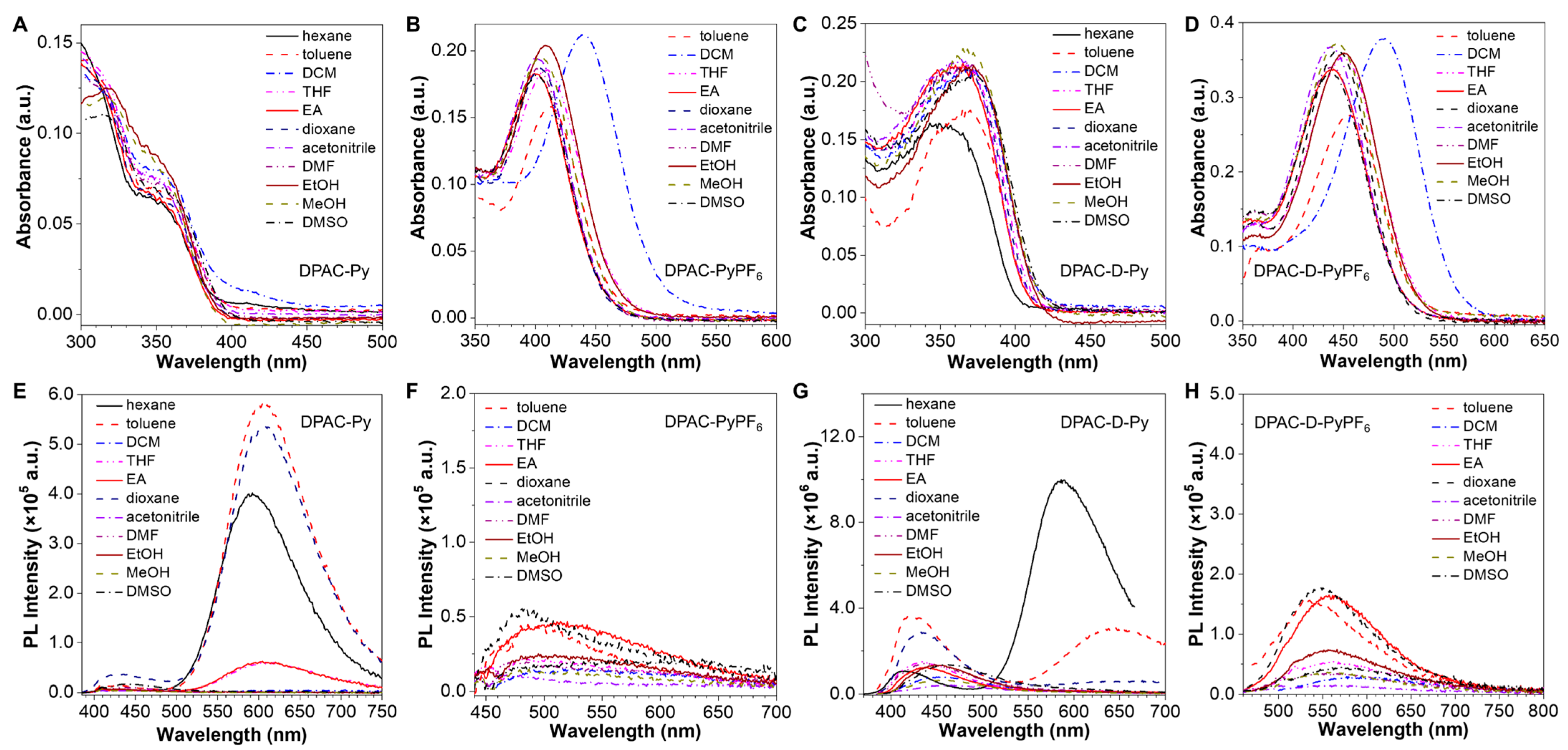
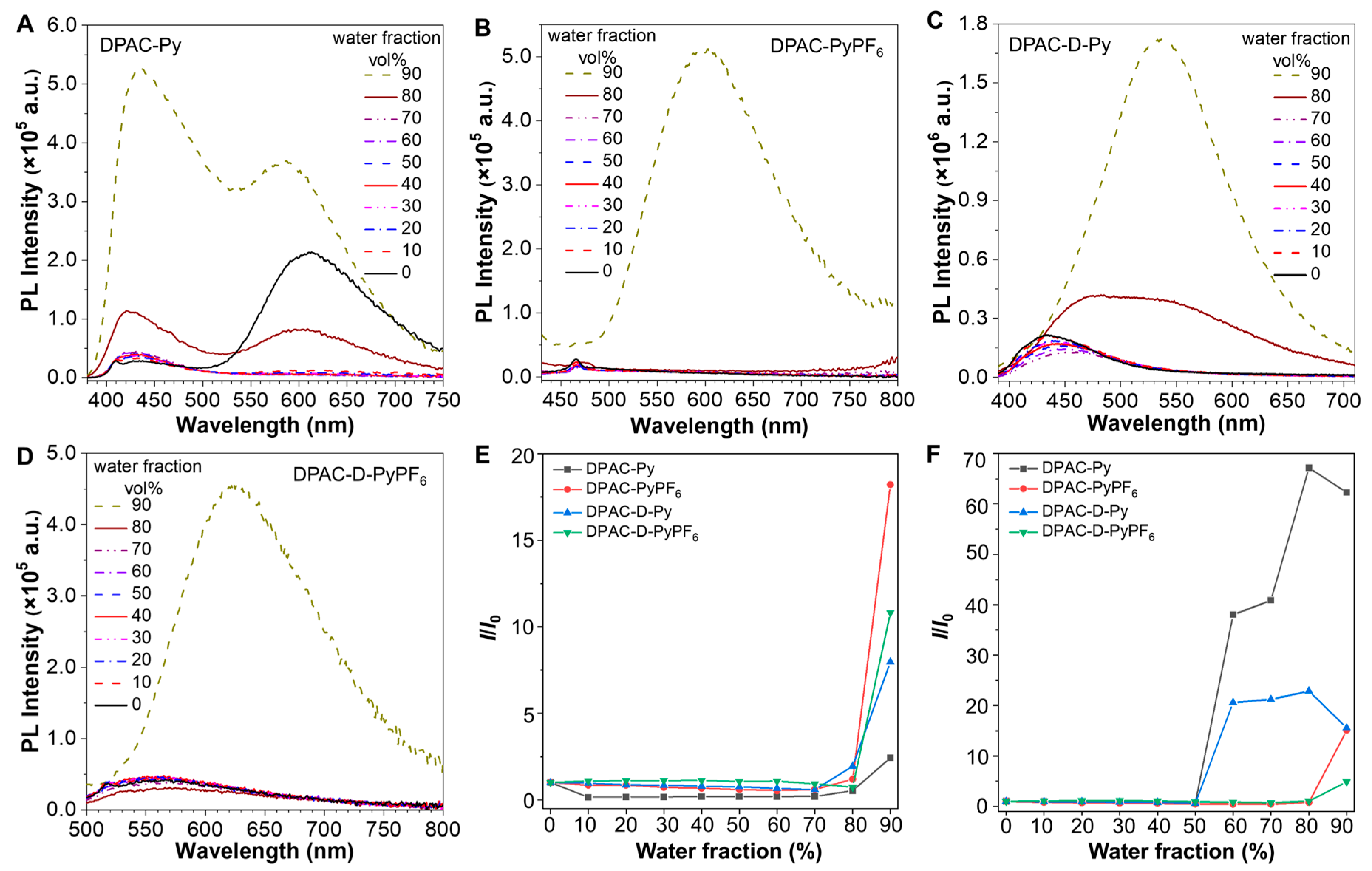
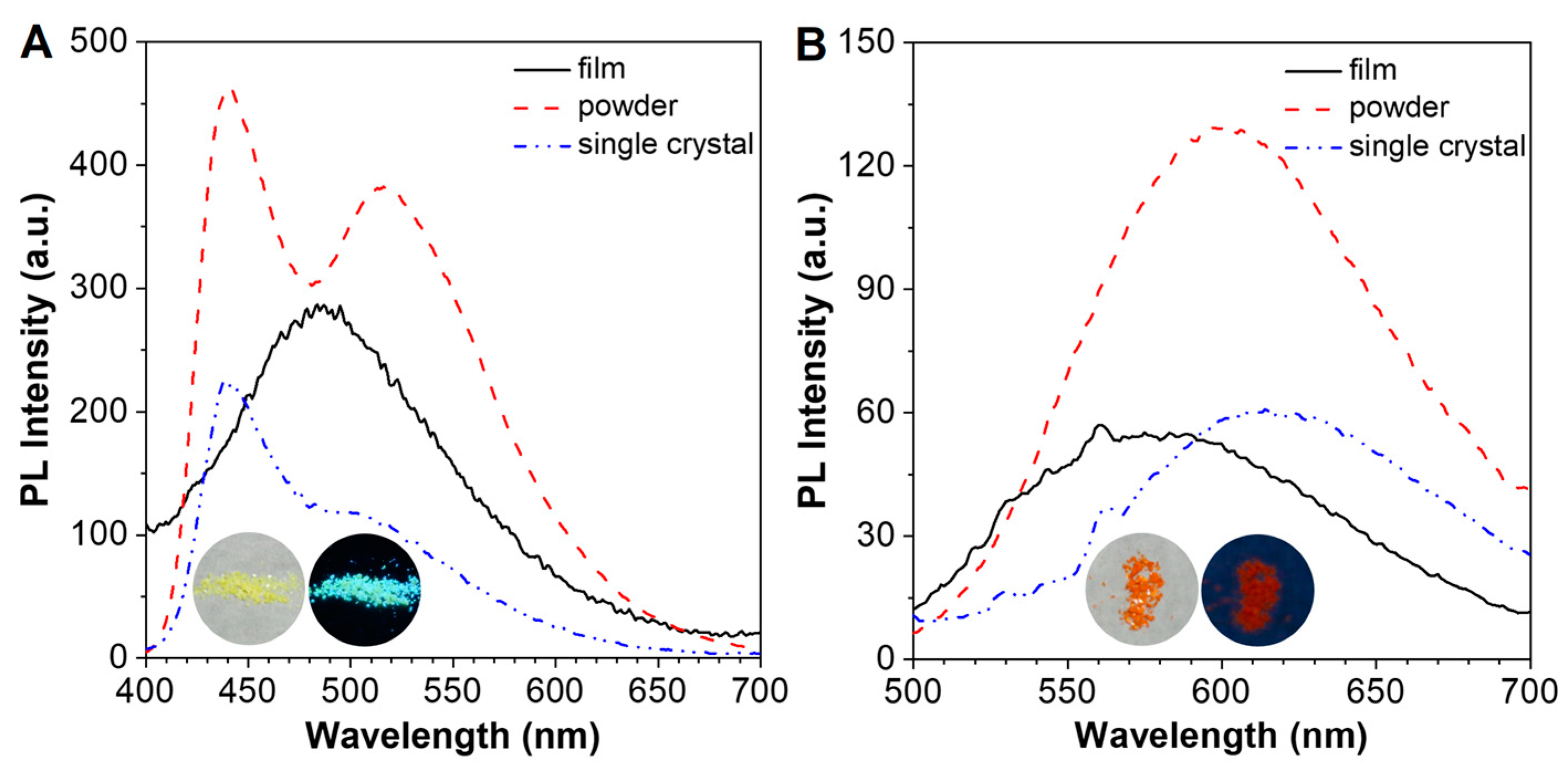

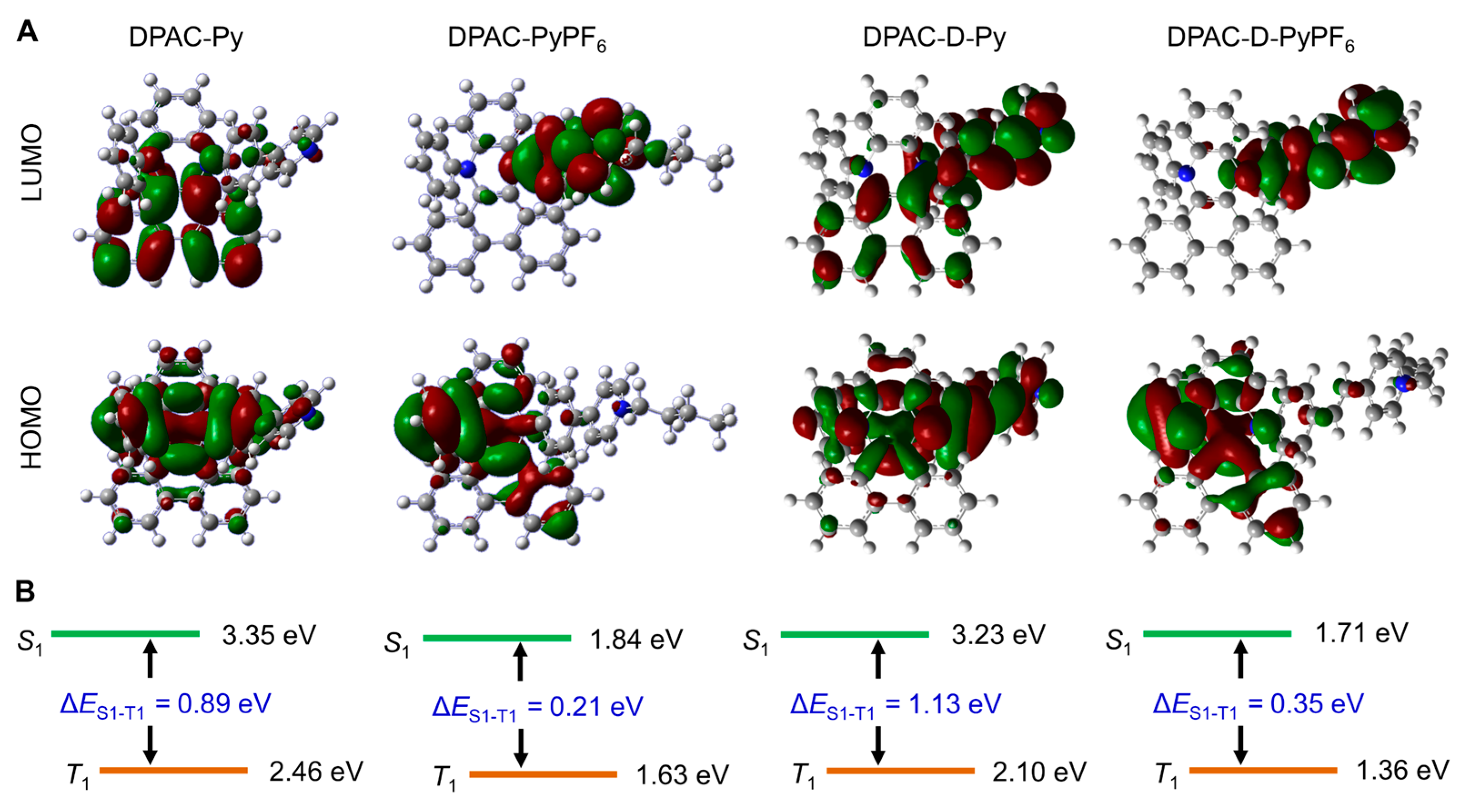


| DPAC-Py | DPAC-PyPF6 | DPAC-D-Py | DPAC-D-PyPF6 | ||
|---|---|---|---|---|---|
| λex/nm | film | 383 | 449 | 386/411 | 455 |
| powder | 387/411 | 487 | 387/425 | 463 | |
| crystal | 386/414 | 500 | / | / | |
| λabs/nm | solution a | 351 | 410 | 367 | 450 |
| aggregate b | 365 | 401 | 384 | 437 | |
| film | 363 | 418 | 378 | 449 | |
| powder | 375 | 416 | 383 | 469 | |
| crystal | 393 | 410/530 | / | / | |
| λem/nm | solution a | 425/610 | N.D. | 434 | N.D. |
| aggregate b | 435/587 | 603 | 535 | 627 | |
| film | 490 | 585 | 435/493/520 | 530/608 | |
| powder | 442/516 | 602 | 537 | 631 | |
| crystal | 440/497 | 615 | / | / | |
| Δλ·c/nm | aggregate b | 70/222 | 202 | 151 | 190 |
| ε·d/L·mol−1·cm−1 | aggregate b | 3.209 × 104 | 2.343 × 104 | 4.462 × 104 | 2.665 × 104 |
| ΦF/% | solution a | 0.11 | 0 | 0 | 0 |
| aggregate b | 0.34 | 0.20 | 0.32 | 0.12 | |
| powder | 8.06 | 0.24 | 3.12 | 0.21 | |
| Comp. | Eg a/eV | Eg b/eV | HOMO c/eV | LUMO d/eV | HOMO e/eV | LUMO e/eV | Eg e/eV |
|---|---|---|---|---|---|---|---|
| DPAC-Py | 3.72 | 3.09 | −4.98 | −1.89 | −5.56 | −1.73 | 3.83 |
| DPAC-PyPF6 | 3.18 | 2.46 | −4.97 | −2.51 | −7.56 | −5.48 | 2.08 |
| DPAC-D-Py | 3.55 | 2.96 | −5.00 | −2.04 | −5.45 | −1.93 | 3.52 |
| DPAC-D-PyPF6 | 2.90 | 2.30 | −4.97 | −2.67 | −7.41 | −5.51 | 1.90 |
Disclaimer/Publisher’s Note: The statements, opinions and data contained in all publications are solely those of the individual author(s) and contributor(s) and not of MDPI and/or the editor(s). MDPI and/or the editor(s) disclaim responsibility for any injury to people or property resulting from any ideas, methods, instructions or products referred to in the content. |
© 2023 by the authors. Licensee MDPI, Basel, Switzerland. This article is an open access article distributed under the terms and conditions of the Creative Commons Attribution (CC BY) license (https://creativecommons.org/licenses/by/4.0/).
Share and Cite
Zhang, Z.; Wang, Q.; Zhang, X.; Mei, D.; Mei, J. Modulating the Luminescence, Photosensitizing Properties, and Mitochondria-Targeting Ability of D-π-A-Structured Dihydrodibenzo[a,c]phenazines. Molecules 2023, 28, 6392. https://doi.org/10.3390/molecules28176392
Zhang Z, Wang Q, Zhang X, Mei D, Mei J. Modulating the Luminescence, Photosensitizing Properties, and Mitochondria-Targeting Ability of D-π-A-Structured Dihydrodibenzo[a,c]phenazines. Molecules. 2023; 28(17):6392. https://doi.org/10.3390/molecules28176392
Chicago/Turabian StyleZhang, Zhaozhi, Qijing Wang, Xinyi Zhang, Dong Mei, and Ju Mei. 2023. "Modulating the Luminescence, Photosensitizing Properties, and Mitochondria-Targeting Ability of D-π-A-Structured Dihydrodibenzo[a,c]phenazines" Molecules 28, no. 17: 6392. https://doi.org/10.3390/molecules28176392
APA StyleZhang, Z., Wang, Q., Zhang, X., Mei, D., & Mei, J. (2023). Modulating the Luminescence, Photosensitizing Properties, and Mitochondria-Targeting Ability of D-π-A-Structured Dihydrodibenzo[a,c]phenazines. Molecules, 28(17), 6392. https://doi.org/10.3390/molecules28176392






